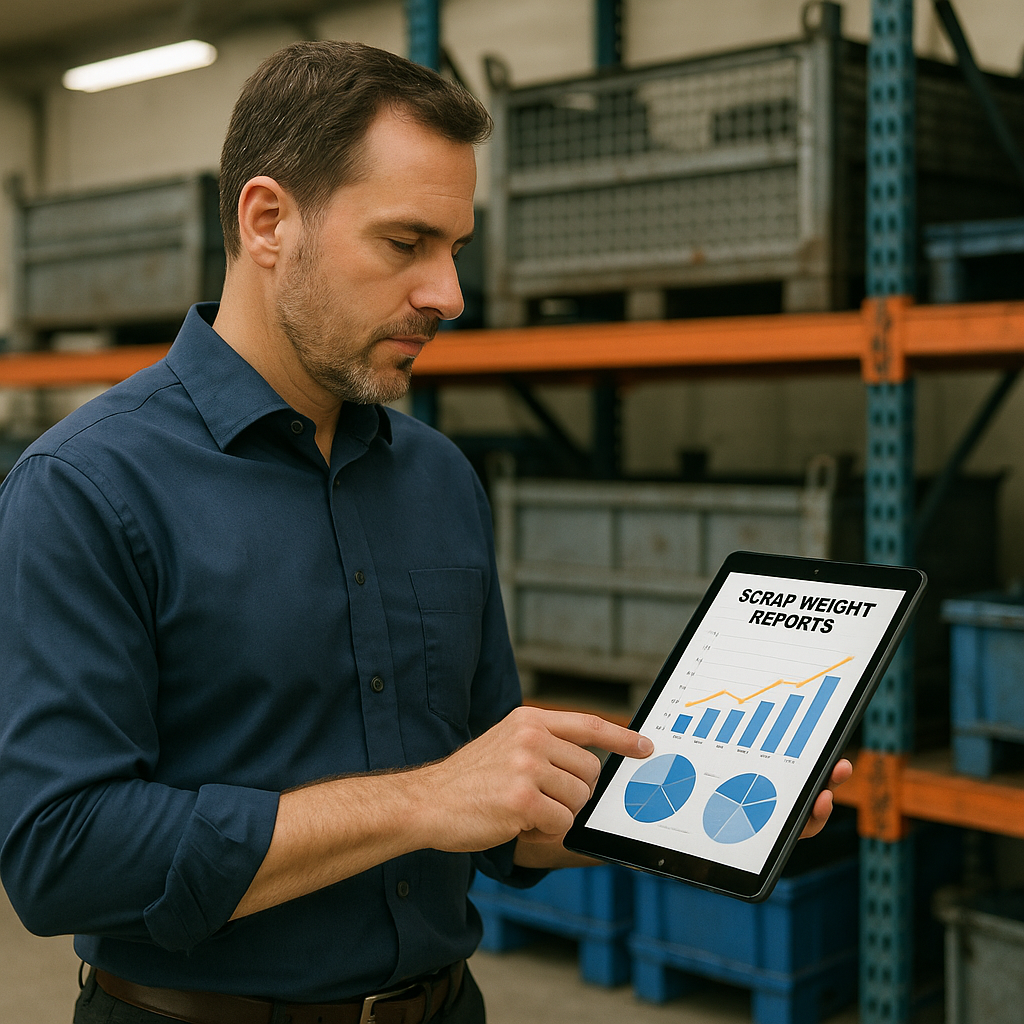5901 Botham Jean Blvd, Dallas, TX 75215
Turning Commercial Scrap Metal into Profit: A Quick Guide
July 19, 2025The pile of metal waste in your facility yard isn’t just taking up space—it’s untapped revenue waiting to be claimed. Businesses across manufacturing, construction, demolition, and fabrication sectors generate substantial metal waste with significant monetary value. With metal prices on the rise, implementing a strategic commercial scrap metal recycling program converts what was once considered waste into a valuable asset.
The financial benefits go far beyond the immediate revenue from selling scrap. Companies implementing comprehensive metal recycling initiatives report significant reductions in waste disposal costs. These savings accumulate quickly, particularly for operations producing high volumes of metal waste.
Additionally, recycling metal requires only a fraction of the energy needed to produce new materials from raw ore—recycled aluminum, for instance, uses just 5% of the energy required for virgin production.
How Do You Set Up a Profitable Commercial Scrap Metal Program?

Setting up a commercial scrap metal program requires thoughtful planning and implementation. Successful programs integrate seamlessly into existing workflows while maximizing the value of materials that would otherwise be discarded. To create a profitable system, focus on several key areas.
Understand Your Scrap Flow
The foundation of any effective scrap metal program is understanding the types of materials you’re generating and their origins. Most commercial operations produce a mix of ferrous metals (containing iron) and non-ferrous metals like aluminum, copper, brass, and stainless steel.
Begin by conducting a waste audit to identify all potential metal streams in your operation. Consider manufacturing processes, maintenance activities, construction projects, and equipment replacement schedules. Document the volume, frequency, and metal types from each source to establish baseline metrics.
For example, a manufacturing facility might generate aluminum shavings from machining operations, steel offcuts from fabrication, and copper wire from electrical work. Each of these streams has different value and handling requirements.
Set Up Strategic Collection Systems
Once you understand your scrap flow, design a collection system that makes sorting easy at the point of generation. Place clearly labeled containers in convenient locations throughout your facility, especially near workstations where scrap is produced.
Container selection is important. Consider factors such as:
- Size and capacity based on volume generated
- Accessibility for workers
- Protection from contamination and weather
- Ease of transport to central collection areas
A good system should be intuitive enough that employees can participate with minimal extra effort. Color-coding containers by metal type improves compliance and reduces contamination, significantly impacting the value of your scrap.
Partner With the Right Commercial Scrap Yard
Not all recycling facilities are equipped to handle commercial accounts effectively. Choose a scrap yard that specializes in working with businesses and understands your industry’s specific needs. The right partner should offer:
- Equipment support, including providing appropriate containers for your site. This might include roll-off containers for larger operations or specialized bins for particular metal types. The partner should be willing to assess your site layout and recommend optimal container placement.
- Flexible pickup schedules that align with your production patterns. Some operations might need weekly service, while others generate enough volume for daily pickups. A good partner will customize the schedule to your needs rather than forcing you into a standard program.
- Transparent pricing and detailed reporting are essential for tracking the performance of your recycling program. Look for partners who provide clear documentation of material weights, types, and payments for each pickup.
Educate Your Team
Even the best-designed scrap program fails without proper team education. Develop a comprehensive training program that explains:
- Which materials go in which containers
- How to identify different metal types
- Proper preparation techniques (removing non-metal attachments, draining fluids)
- The importance of preventing contamination
Create simple visual guides and post them near collection points. Consider designating recycling champions within different departments who can answer questions and provide ongoing guidance.
Regular refresher training keeps everyone informed about program updates and reinforces best practices. Share success metrics with the team to demonstrate the impact of their participation.
Maximize Material Value Through Proper Preparation
The condition of your scrap significantly impacts its value. Implement procedures for proper material preparation before collection. This typically includes:
- Separating different metal types thoroughly. Even small amounts of contamination can downgrade an entire load. For instance, copper wire with steel attachments will fetch a lower price than clean copper.
- Removing non-metal components whenever possible. Plastic insulation, rubber gaskets, or other attachments reduce the value of your scrap and may incur processing fees.
- Keeping materials clean and dry. Excessive dirt, grease, or moisture can reduce weight-based payments and may cause your materials to be downgraded to a lower value category.
Track Performance and Optimize
A profitable scrap metal program requires ongoing monitoring and refinement. Establish key performance indicators (KPIs) such as:
- Total weight recycled by metal type
- Revenue generated from recycling
- Contamination rates
- Participation rates across departments
Review these metrics regularly to identify improvement opportunities. For example, if you notice one department consistently has higher contamination rates, targeted training might be warranted.
Compare your returns against market benchmarks to ensure you’re receiving competitive prices for your materials. Metal prices fluctuate based on market conditions, but your relative returns should remain consistent.
What Factors Affect the Value of Your Commercial Scrap Metal?

The value of your commercial scrap metal depends on multiple factors that recyclers consider when determining payouts. Understanding these elements can help you maximize returns on your recyclable metal assets.
Metal Type and Grade
Different metals command vastly different prices in the recycling market. Non-ferrous metals like copper, aluminum, and brass are typically more valuable than ferrous ones like steel and iron. For instance, clean copper can fetch 3-4 times more per pound than aluminum, while stainless steel generally commands higher prices than regular steel scrap.
Even within the same metal category, grades matter significantly. Pure copper wire can be worth substantially more than copper mixed with other materials. For example, bare bright copper wire (99% pure) might earn $3-4 per pound, while copper with insulation might only fetch $1-2 per pound because it requires additional processing.
Cleanliness and Contamination
Clean, uncontaminated scrap consistently earns higher payouts. Metal with coatings, paint, oil, or other contaminants requires extra processing at the recycling facility, reducing its value. A load of aluminum extrusions with plastic or rubber attachments will bring less than the same amount of clean aluminum.
Steel contaminated with other metals, excessive rust, or dirt can see price reductions of 10-30% compared to clean alternatives. The effort required to prepare and clean materials before recycling directly impacts your bottom line.
Volume and Quantity
Larger quantities of scrap metal typically command better rates. Many recyclers offer tiered pricing structures that reward businesses bringing in full truckloads rather than small batches. This pricing advantage exists because larger volumes reduce the recycler’s per-unit processing costs.
Commercial clients with regular, substantial scrap generation can often negotiate better long-term rates than those with irregular, smaller quantities. Some recyclers might offer a 5-15% premium for consistent, large-volume suppliers.
Market Conditions and Commodity Prices
Scrap metal prices fluctuate based on global supply and demand, economic conditions, and the prices of virgin metals. These market dynamics can cause significant price swings within short periods. For example, during supply chain disruptions in 2024, steel scrap prices saw fluctuations of over 25% within three months.
Prices are also influenced by energy costs, production expenses, and international trade policies. New Electric Arc Furnace mill capacity coming online can boost demand for certain scrap types, potentially raising prices as mills compete for available materials.
Sorting and Preparation
Pre-sorted scrap metals bring higher returns than mixed loads. Separating ferrous from non-ferrous metals, and further sorting by type and grade, reduces work for the recycler and increases your payout. A load of mixed metals might bring 30-50% less than the same materials properly sorted.
Simple preparation steps make a big difference. Removing non-metal attachments, draining fluids from components, and bundling similar materials together all enhance value. For example, aluminum radiators with copper removed might bring only half the price of separated aluminum and copper components.
Transportation and Logistics
The distance from your facility to the recycling center affects net returns, especially for lower-value ferrous scrap. Transportation costs can significantly impact profitability for bulky, lower-value metals. Some recyclers offer transportation services or adjustments to the price based on delivery versus pickup.
Strategic logistics planning, including proper loading, efficient transportation, and timing deliveries during favorable market conditions, can enhance your overall returns. Full-load transactions generally command higher prices due to reduced handling and processing costs compared to partial loads.
Relationship with Recyclers
Building a relationship with a reputable recycler can lead to preferential pricing, better service, and valuable market insights. Regular suppliers often receive priority service, more accurate sorting, and potentially better prices than one-time sellers.
Professional recyclers can also provide guidance on how to better prepare and sort your materials to maximize value, creating a mutually beneficial partnership that enhances returns over time.
How Can You Track and Improve Your Scrap Metal Program?

Viewing your scrap metal as valuable data rather than just waste can transform your recycling efforts from mere disposal to a strategic business asset. Each pound of material that moves through your facility provides critical information for driving process improvements and enhancing profitability.
Establish Key Performance Indicators
Begin by identifying the metrics that are most relevant to your operation. Effective tracking starts with setting clear KPIs that align with your business aims. Monitor total volume by weight, distribution of material types, and revenue generated per ton for each category.
Beyond these, observe contamination rates, processing costs, and transportation expenses to get a comprehensive overview of your program’s performance, highlighting specific areas needing improvement.
Utilize Yard Reporting Tools
Most modern scrap yards provide advanced reporting capabilities that should be fully utilized. These reports typically include detailed weight tickets, material classification data, and payment summaries categorized by material type and grade. Request digital versions for more in-depth analysis.
Many yards now offer customer portals or apps for real-time access to transaction history, current market prices, and customized reports, making data collection easier and more accurate than manual methods.
Implement Data Collection Systems
Larger operations should consider setting up an internal tracking system before materials leave your facility. While spreadsheets may suffice for smaller setups, dedicated software solutions offer more robust analytical capabilities for complex programs.
Document each scrap load with consistent data points: origin location, material type, weight, date, and eventual destination. Photos can verify material quality and help resolve discrepancies with recycling partners.
Analyze Trends and Patterns
Regular analysis of data reveals valuable insights about your scrap metal program. Identify seasonal patterns in volume and material types, which can inform staffing or storage decisions. Determine which production areas generate the most valuable scrap and which produce problematic materials.
Compare your recovery rates with industry benchmarks to see if you’re capturing an appropriate percentage of potentially recyclable materials. Significant deviations could indicate collection inefficiencies or diversion issues.
Make Data-Driven Improvements
Use your analysis to implement targeted improvements in your scrap program. If data indicates high contamination in specific material streams, provide additional training or adjust collection containers. For inefficient transportation schedules, consider consolidating pickups or adjusting container sizes.
Track the impact of each change by comparing performance metrics before and after implementation. This feedback loop guides continuous improvement and justifies further investment in your recycling infrastructure.
Optimize Material Sorting
Data often reveals opportunities to increase revenue through enhanced sorting practices. Analyze the price differences between mixed and segregated materials to determine where additional sorting labor is financially beneficial.
For instance, if separated copper wiring commands a higher price than mixed metals, the extra labor needed to segregate this material may be offset by increased revenue. Your tracking data helps quantify these decisions rather than relying on assumptions.
Negotiate Better Terms
Detailed data about your scrap metal program strengthens your position in negotiations with recycling partners. Detailed volume reports, consistent material quality metrics, and predictable generation patterns enhance your business value to recyclers.
Leverage this data to negotiate better pricing, reduced processing fees, or improved service terms. Many yards offer premium pricing to customers who deliver clean, well-sorted materials in predictable volumes—factors you can demonstrate with effective data tracking.
Calculate True Program Value
Comprehensive tracking allows you to evaluate your scrap program’s full value beyond just recycling revenue. Consider avoided disposal costs, reduced storage requirements, and any regulatory compliance benefits in assessing program performance.
This holistic view often uncovers that your scrap metal recycling program delivers significantly more value than revenue figures alone suggest, supporting continued investment in program enhancement.
By viewing your scrap metal as valuable data points instead of waste, you can transform it into a strategic business function with measurable returns and continuous improvement opportunities.
Conclusion: Maximizing Your Commercial Scrap Metal Profits

A successful commercial scrap metal recycling program transforms waste into a valuable business asset. The process begins with understanding your scrap flow. Knowing what types of metals you generate and their sources lays the foundation for an effective recycling strategy. This knowledge helps determine the right equipment and systems needed to optimize returns.
Setting up efficient collection systems with properly labeled containers, strategic placement, and good storage practices ensures your materials maintain their value. Collaborating with recycling partners who understand commercial operations provides expertise in sorting practices, container solutions, and market insights. Tracking results through detailed reporting allows you to identify opportunities for continuous improvement and demonstrates your commitment to sustainability goals.
Interested in turning your metal waste into profit while supporting environmental sustainability? Contact Okon Recycling at 214-717-4083 for a professional assessment of your commercial scrap metal recycling needs.
